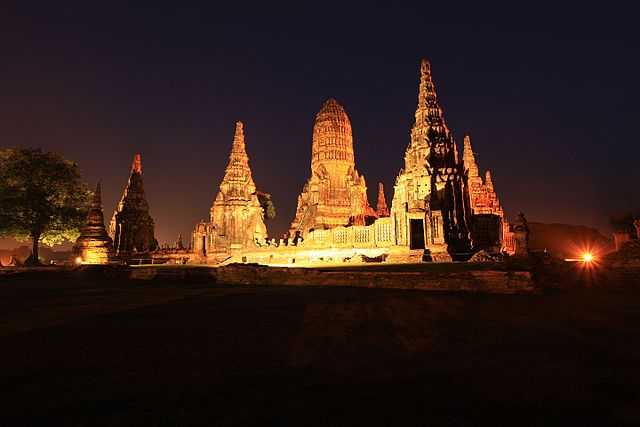Wat Chaiwatthanaram
₹ 257 onwards
View Ayutthaya PackagesWeather :
Tags : Buddhist Temple
Timings : 8:00 AM - 6:00 PM
Entry Fee : THB 50
Wat Chaiwattanaram, Ayutthaya Overview
Wat Chaiwatthanaram, located in Ayutthaya, Thailand is a renowned Buddhist Temple constructed according to the Khmer style. It was predominately a royal temple where the king, along with the rest of the royal family, worshipped in private. The holy shrine is situated opposite the South Western end of the highly popular Ayutthaya Historical Park. Tourists enjoying a boat trip on the Chao Phraya river can view the impressive Wat Chaiwatthanaram from afar as well.
It is a common halting point for the tourist boats and dinner cruise vessels with the visitors enjoying the spectacular sight of the tall temple that is lit up at night. It also serves as a vantage sunset point with the tour guides making sure to provide their customers with a magnificent natural show amidst the river.
Wat Chaiwatthanaram is known for its elaborate detailing conforming to the 17th century Khmer architecture with the top tower known as prang attracting instant attraction. While the purpose of the construction has been debated fiercely by historians, there is little doubt that it remains one of the focal tourist attractions across Thailand today. Although much of the past glory of Wat Chaiwatthanaram has vanished today with the temple sustaining damage over the centuries, yet the remaining parts still evoke awe, inspiring tourists to visit it from distinct places across the world. It had been last restored in 2011 after extensive parts of Thailand as well as the Ayutthaya Island remained submerged under water for a long time.
Read More on Wat Chaiwattanaram
History & Significance of Wat Chaiwatthanaram

The term, ‘wat’ denotes a temple dedicated to Lord Buddha or a monastery complex. Wat Chaiwatthanaram had been constructed by the reigning ruler Prasat Thong back in 1630 who held sway over the Ayutthaya Kingdom. The entire complex was built according to the Khmer style of architecture prevalent in the 17th century and dedicated to victory and progress, a literal translation of the name by which the temple is known. It is believed to have been constructed as a memorial to his mother, the erstwhile Queen.
Wat Chaiwatthanaram houses a couple of chedis on its Eastern side where the urns containing her ashes have been preserved. However, the existence of huge amounts of cannon balls along with parts of cannon guns retrieved by the archaeologists suggests that the monastery had been used as a fortress to combat the enemy during the Burmese War that took part in 1767. The monument was looted and ransacked by the victorious Burmese troops later on, and the area was deserted completely. The Fine Arts Department of Thailand managed to restore it in the late 1980s and turned it into a heritage site that enjoys numerous visitors today with all of them eager to learn more about the historical facts associated with the Ayutthaya Kingdom.
Architecture of Wat Chaiwatthanaram

Wat Chaiwatthanaram was built in keeping with the principles of Khmer architecture that is found in the temples of Angkor. It represents the universe as per the Buddhist & Hindu philosophy. The tourists approaching the ruined complex find a 1 meter wide wall encircling it completely. It consists of several arched entrances. The principal gate facing the Chao Phraya River lies to the east of the building. The royal family along with the King had used a boat to visit the temple in ancient times.

A 35 meter high prang or tower happens to be the hallmark of the complex that has been raised by means of a flat rostrum. The area also contains four smaller towers situated at the four corners. There is a flight of stairway leading upwards to the central tower from each of the smaller ones. The eastern tower, however, also leads to a sanctum holding multiple ancient relics and other artefacts believed to be of significance. The main podium supporting the prang also consists of eight chedis that are interconnected to form a gallery.

Each of the lean towers contains niches that hold images of Lord Buddha, sitting in a penance. The walls of the chedis are sculpted elaborately with depiction from the tales of Jataka from Buddhist folk lore. The galleries also contain lacquered images of Buddha in the Mara Mudra formation. The walls along with the windows exist to this day while the roof has been ravaged by time. The base of the Eastern alter with images of Buddha in a sitting posture have survived although the monks’ quarters have been demolished completely.
Tips
- It is safe to carry drinking water and a few nourishments for exploring the ruins extensively
- A day time trip can prove to be tiring so it is advisable to visit the temple right after it opens or in the evening
- Hiring an English speaking guide would prove to be invaluable for learning much about the history of the place
- Young people and locals prefer to hire bicycles for THB 50 for travelling through different sites within the area
- There is no restriction for carrying cameras but it is essential to keep it in a bag so that the equipment does not get heated thus functioning ineffectively
How To Reach Wat Chaiwatthanaram
-
By Train - It is best to get to Ayutthaya by taking the train from Hua Lamphong railway station in exchange for THB 15.
-
By Car - Many visitors opt for reaching the Uthong Road via minivans and cross over the bridge spanning the Chao Phraya River to reach their destination.
Top Hotel Collections
Top Hotels Near Wat Chaiwattanaram
Wat Chaiwattanaram Reviews

Have a Question on Wat Chaiwattanaram?

experience.